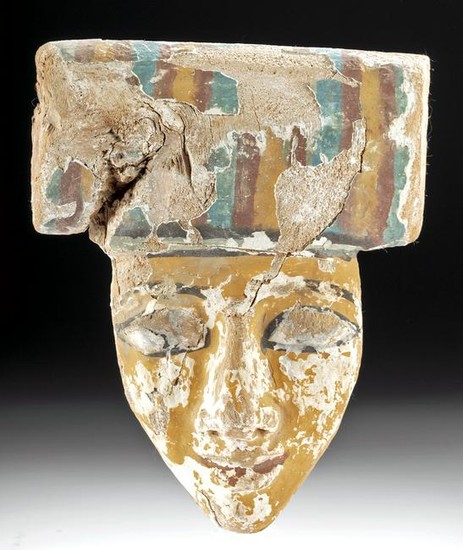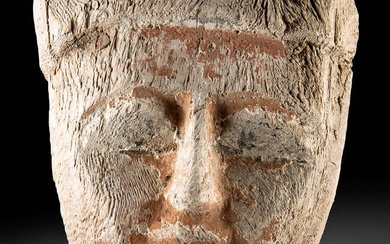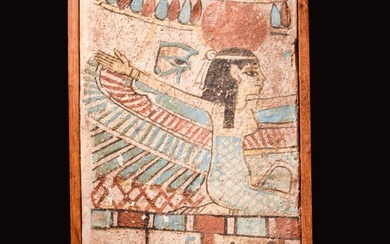Egyptian Ptolemaic Cedar / Gesso Mummy Mask
Egypt, Ptolemaic Period, ca. 332 to 30 BCE. A hand-carved cedar mummy mask with an acorn-shaped face topped with a broad headdress. The delicate visage is defined by almond-shaped eyes outlined in black, a slender nose with petite nostrils, thin lips, a tapered jawline, and a smooth forehead. Layers of white gesso are painted with vivid hues of yellow, black, white, blue, vermilion, and teal, and vertical polychrome bars decorate the top of the rectangular headdress. The verso exhibits two original dowel holes as well as the fine graining of the cedar. Lucite display stand for photography purposes only. Size: 6" W x 7.375" H (15.2 cm x 18.7 cm).
Ancient Egyptians believed it was of the utmost importance to preserve a body of the deceased, because the soul needed a place to reside after the death. Preservation of the body was done via mummification - a process involving the removal of internal organs that were placed in canopic jars, wrapping body in linen, and then embalming. Death masks like this example were created so that the soul could recognize the body and return to it. For this reason, death masks were made in the likeness of the deceased. Artisans used different materials. Earlier masks were carved from wood, while later ones were made of cartonnage, a material made from papyrus or linen and soaked in plaster which was then applied to a wooden mold, was used. Royal death masks, perhaps the most famous being that of Tutankhamen, were made from precious metals. All death masks were intended to resemble the deceased subject; however, eyes were always slightly enlarged and lips presented in a subtle smile, as we see in this example.
The mask was an essential part of the mummy, placed over the head to provide an idealized image of the deceased as he or she would be resurrected. This mask and others like it were traditionally carved from cedar. Interestingly, cedar wood was not native to Egypt. Egypt did not have verdant forests filled with tall trees, and unfortunately most of its native lumber was of relatively poor quality. So the ancient Egyptians relied on importing to acquire hardwoods - ebony imported from Africa, cedar and pine from Lebanon. One fabulous obelisk inscription by Thutmose III attests to the luxury of treasured hardwoods. It reads as follows, "They brought to me the choicest products . . . consisting of cedar, juniper and of meru wood . . . all the good sweet woods of God's Land." (Obelisk inscription by Thutmose III - J. H. Breasted, Ancient Records of Egypt, Part Two, p. 321)
Provenance: private A.G. collection, Chicago, Illinois, USA, purchased from a dealer in Zurich, Switzerland, prior to 1980
All items legal to buy/sell under U.S. Statute covering cultural patrimony Code 2600, CHAPTER 14, and are guaranteed to be as described or your money back.
A Certificate of Authenticity will accompany all winning bids.
We ship worldwide to most countries and handle all shipping in-house for your convenience.
#150150
Condition Report: Losses to areas of headdress, peripheries, verso, and painted gesso as shown. Several stable fissures, nicks to gesso, face, headdress, and peripheries, with fading to areas of original pigment, and light encrustations. Nice earthen deposits, great patina, and wonderful traces of original painted gesso throughout.
View it on
Estimate
Time, Location
Auction House
Egypt, Ptolemaic Period, ca. 332 to 30 BCE. A hand-carved cedar mummy mask with an acorn-shaped face topped with a broad headdress. The delicate visage is defined by almond-shaped eyes outlined in black, a slender nose with petite nostrils, thin lips, a tapered jawline, and a smooth forehead. Layers of white gesso are painted with vivid hues of yellow, black, white, blue, vermilion, and teal, and vertical polychrome bars decorate the top of the rectangular headdress. The verso exhibits two original dowel holes as well as the fine graining of the cedar. Lucite display stand for photography purposes only. Size: 6" W x 7.375" H (15.2 cm x 18.7 cm).
Ancient Egyptians believed it was of the utmost importance to preserve a body of the deceased, because the soul needed a place to reside after the death. Preservation of the body was done via mummification - a process involving the removal of internal organs that were placed in canopic jars, wrapping body in linen, and then embalming. Death masks like this example were created so that the soul could recognize the body and return to it. For this reason, death masks were made in the likeness of the deceased. Artisans used different materials. Earlier masks were carved from wood, while later ones were made of cartonnage, a material made from papyrus or linen and soaked in plaster which was then applied to a wooden mold, was used. Royal death masks, perhaps the most famous being that of Tutankhamen, were made from precious metals. All death masks were intended to resemble the deceased subject; however, eyes were always slightly enlarged and lips presented in a subtle smile, as we see in this example.
The mask was an essential part of the mummy, placed over the head to provide an idealized image of the deceased as he or she would be resurrected. This mask and others like it were traditionally carved from cedar. Interestingly, cedar wood was not native to Egypt. Egypt did not have verdant forests filled with tall trees, and unfortunately most of its native lumber was of relatively poor quality. So the ancient Egyptians relied on importing to acquire hardwoods - ebony imported from Africa, cedar and pine from Lebanon. One fabulous obelisk inscription by Thutmose III attests to the luxury of treasured hardwoods. It reads as follows, "They brought to me the choicest products . . . consisting of cedar, juniper and of meru wood . . . all the good sweet woods of God's Land." (Obelisk inscription by Thutmose III - J. H. Breasted, Ancient Records of Egypt, Part Two, p. 321)
Provenance: private A.G. collection, Chicago, Illinois, USA, purchased from a dealer in Zurich, Switzerland, prior to 1980
All items legal to buy/sell under U.S. Statute covering cultural patrimony Code 2600, CHAPTER 14, and are guaranteed to be as described or your money back.
A Certificate of Authenticity will accompany all winning bids.
We ship worldwide to most countries and handle all shipping in-house for your convenience.
#150150
Condition Report: Losses to areas of headdress, peripheries, verso, and painted gesso as shown. Several stable fissures, nicks to gesso, face, headdress, and peripheries, with fading to areas of original pigment, and light encrustations. Nice earthen deposits, great patina, and wonderful traces of original painted gesso throughout.





